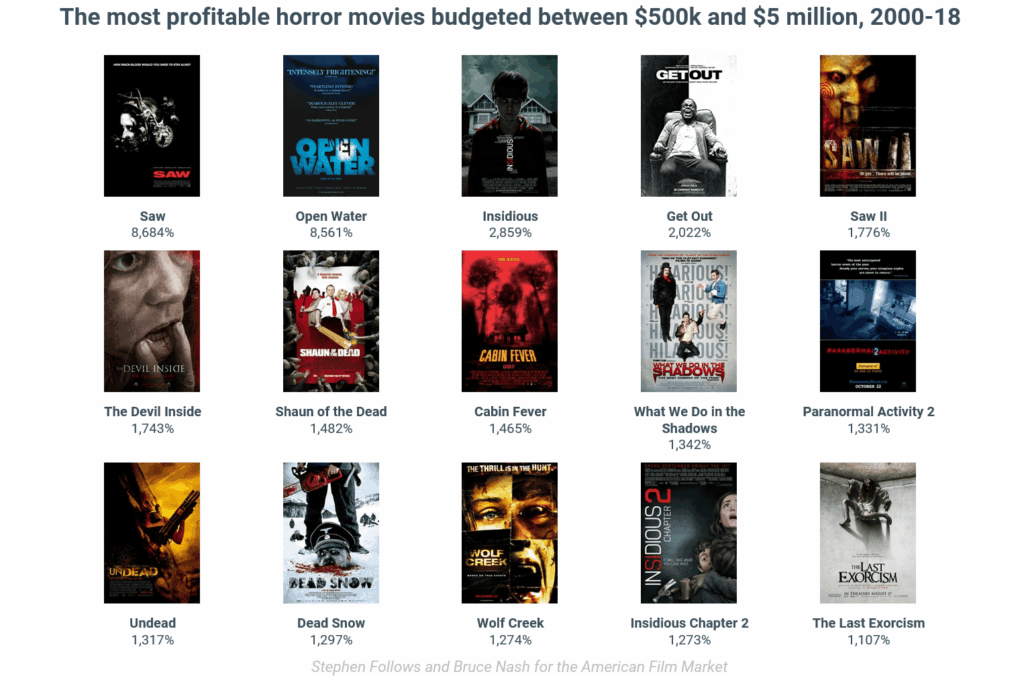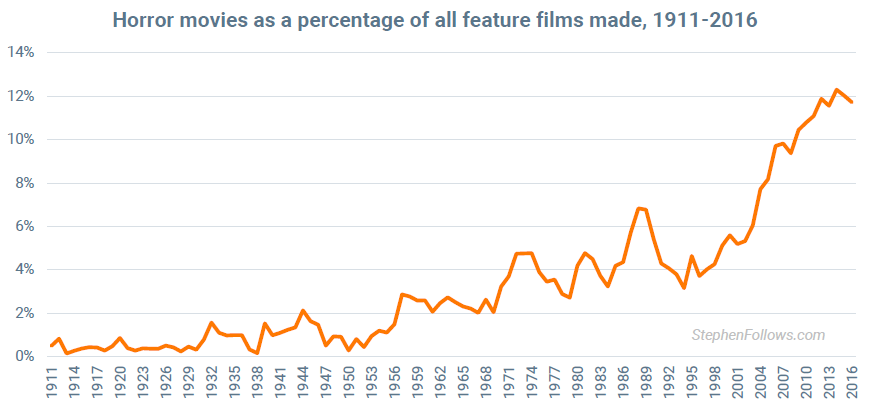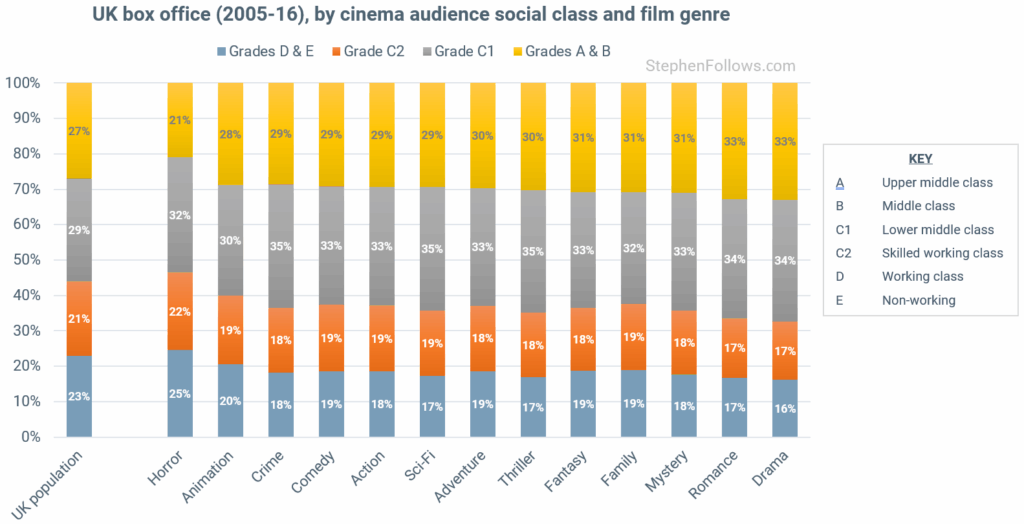PRODUCER RESOURCES
WHAT THE DATA SAYS: PRODUCING LOW-BUDGET HORROR FILMS
Smart, data-driven decisions can help independent producers succeed. We have crunched the numbers on what to make and how to make it.
For this article, we are taking a look at the horror genre. Specifically, horror movies budgeted between $500,000 and $5 million, released domestically 2000-16.
We have boiled down all our data, statistics and modelling to a number of quick takeaways on the horror genre. They are:
- Horror movies are the most profitable genre
- …but also the riskiest genre
- Quality doesn’t matter all that much
- Your release will either be very wide or very small
- Horror audiences are more likely to be working class
Let’s dive in and look at each of these findings in detail…
1. Horror Movies Are the Most Profitable Genre
Using real-world data and statistical modelling, we are able to estimate the profitability of most major horror movies. This takes into account all income streams (from theatrical through to television syndication) and offsets all costs (including advertising, distribution and fees). We are left with a fairly accurate estimation of the Producers Net Profit for each movie.
At the top of the pile is Saw, which was hugely successful, with a likely profit of well over $130 million on a $1.2 million production budget.
In the table below, profitability is expressed as a percentage return on the reported production budget. i.e. a film which cost $2 million to make and made a Producers Net Profit of $4 million would show up as having profitability of 200%.

N.B. “Where’s Paranormal Activity?!” you may be thinking This study is focusing on movies budgeted between $500k and $5 million meaning that Paranormal Activity is too inexpensive to be on the list. If we had included it, it would have appeared at the top, with a public-budget-to-estimated-profit ratio of over 20,000%!
When we widen our focus and broaden our statistical model to look at all movies released, horror appears to be the most profitable of the genres. We estimate that just over half of all horror movies released in US cinemas made a profit when all costs have been taken into account. This is significantly better than dramas, of which we estimate only a third make back their total costs.

2. …but also the riskiest
Based on the analysis so far, you might be asking the question, “Why would anyone make anything but horror films?” The answer to this is two-fold. First, perhaps assisted by the favourable image from profitability statistics, horror is becoming a much more frequently-produced genre.

And secondly, it’s not all rosy. The profitability and production figures hide a risky aspect to horror films. While profitable horror films are common, so too are horror films incurring big losses. This can be seen in how long movies of each genre stay available to the public in cinemas.
On average, documentaries stay in theatres for almost 5 weeks, whereas horror movies are gone in half that time.

What this means in practice is that horror films are much more reliant on their opening weekend to make money than other genres, and therefore much more reliant on good marketing, and a measure of luck.
3. Quality Doesn’t Matter All That Much
Given the necessity for clever marketing and a good opening, it isn’t a huge surprise that, more than any other genre, the quality of a horror movie doesn’t matter all that much.
When we look at the ratings given by film audiences and film critics to the most profitable horror movies we can see that they range across the spectrum. A similar chart for, say, drama, would show a bunching of dots in the top right, showing that the quality of a drama is heavily correlated to its financial success.

That blue dot (6.4 IMDb users score and 55 Metascore) represents the average for all movies released in US cinemas. This shows that more than half of the profitable horror movies in this study are worse than the average of all movies, further underlining how weak the correlation is between quality and profitability for horror movies. Even profitable horror movies were considered, on average, to be mediocre by critics and audiences alike.
4. Your Release Will Either Be Very Wide or Very Small
If your film gets picked up for a domestic theatrical release then it’s likely to get one of two releases – either very wide (i.e. over 2,000 theatres) or very small (i.e. under 50 theatres).
Why so few films in the middle ground? Again, this comes back to the relatively short legs for horror movies. The two successful release strategies are:
- The big studio model: get the film into as many theatres as possible on opening weekend, and hope for big crowds.
- The indie release model: tour the film around the country, playing it for short runs in different venues over time.

5. Horror Audiences Are More Likely To Be Working Class
Using exit polls of UK cinema audiences, we can see that horror movies are disproportionately enjoyed by people on the lower end of the class spectrum when compared to all other genres. Only 21% of people watching horror movies are in the top two class brackets (i.e. “A” and “B”) whereas it’s 33% for dramas.

This doesn’t say that highbrow horror films can’t exist or make money, but just that the majority of successful horror movies are not artsy affairs. They play to an audience that aligns most with the make-up of the general population.
Bonus Data: Horror Movie Posters Follow a Small Number of Templates
There are ten templates most frequently used to promote horror movies.

Conclusion
The good news is that horror is a genre that reliably produces hit movies, often on very modest budgets. In fact, measured purely in terms of profit, horror is the best genre in the industry.
The bad news is that horror is also the most hit and miss genre, with films relying on good marketing, and some luck, in order to make money. That makes it particularly important for an independent producer to find a good distributor – someone who knows how to find an audience for their film and can spend their marketing budget wisely.
The key task for the filmmaker is to think of a good hook for the film that will make the distributor’s marketing job as easy as possible. It’s worth thinking about that as early as possible in the process. Consider, for example, how the most successful horror movies of recent years (Saw, Paranormal Activity, Get Out, The Purge) were all able to convey a clear message in their trailers and posters.
Notes
- Unless otherwise stated in the text, today’s research focused on all horror films with public budgets between $500,000 and $5 million released in North American cinemas between 1st January 2000 and 31st December 2015. The UK class data is for all films released in UK cinemas for which there was exit poll data, regardless of budget. This is because exit poll data is rarely available for lower budget films and so we felt it was better to show the film movie data rather than exclude the section entirely.
- The recoupment ratios are based on the “shot for” budget figure, rather than the final cost of finishing the film ready for commercial distribution. Studios will typically spend money post-acquisition (such as shooting new footage, post-production and music rights) and also on the Prints and Advertising needed to bring the movie to paying audiences. These additional costs have been taken into account in our modelling for producers net profit – it’s only the headline ratio figure in which they are absent.
Further Reading
If you want to learn more about the horror genre then you may be interested in The Horror Report, written by one of this article’s co-authors, Stephen Follows. Find out more at stephenfollows.com/horrorreport.
About the Authors
Stephen Follows is a writer, producer and film industry analyst. His film research has been featured in the New York Times, The Times, The Telegraph, The Guardian, The Daily Mail, The Mirror, The Evening Standard, Newsweek, The New Statesman, AV Club and Indiewire. He acted as an industry consultant and guest on the BBC Radio 4 series The Business of Film, which topped the iTunes podcast chart, and has consulted for a wide variety of clients, including the Smithsonian in Washington. In addition to film analytics, Stephen is an award-winning writer-producer and runs a production company based in Somerset House, London.
Bruce Nash is the founder and President of Nash Information Services, LLC, the premier provider of movie industry data and research services and operator of The Numbers, a website that provides box office and video sales tracking, and daily industry news. Mr. Nash founded the company in 1997 and it now serves approximately 1,000 clients, from the major studios to first-time independent filmmakers. Mr. Nash provides regular commentary and analysis for media outlets, including the L.A. Times, the New York Times, Variety, the Wall Street Journal, 60 Minutes, and CBS News. Mr. Nash is the official adjudicator of movie records for the Guinness Book of Records. To learn more about his company’s services, visit Nash Information Services.
Copyright © 2021 Stephen Follows and Bruce Nash. All rights reserved. Reproduced with permission.
Explore more articles and research at Producers Resources.